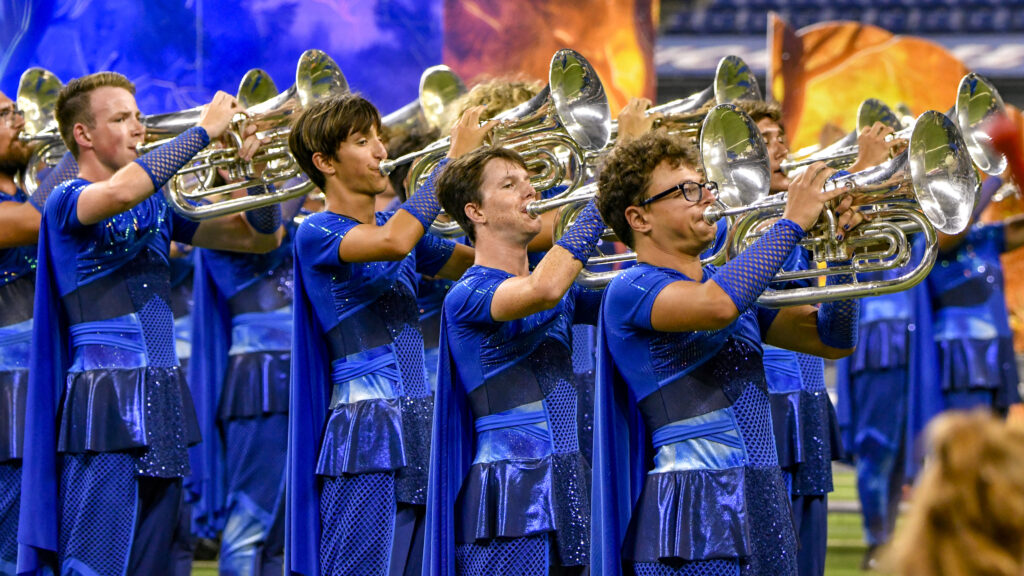The 1999 Drum Corps International Tour ended with a tie for the title between Blue Devils and Santa Clara Vanguard.
Fans attending World Championships Week events at Madison, Wisconsin’s Camp Randall Stadium also witnessed a number of other benchmarks that season: Cadets of Bergen County became simply The Cadets, Crossmen celebrated its 25th anniversary, and Boston Crusaders earned a spot among the top 12 in the Finals competition for the very first time since DCI’s founding in 1972.
1999 was also the last year for eighth-place Phantom Regiment’s solid black uniforms, as well as the last year the corps performed a brass book arranged by the legendary Jim Wren, who had written for the corps an astounding 32 years.
Regiment’s show, “Tragedy and Triumph: The Music of Pyotr Ilyich Tchaikovsky,” was based on the Russian Romantic composer’s final three symphonies, “Symphony No. 4” of 1877-1878, “Symphony No. 5” of 1888, and “Symphony No. 6” of 1893, his final work. While the “4th” was loaded with optimism, his final two symphonies were undeniably dark and foreboding, reflecting the depression with which he dealt most of his life.
The show started with several silent counts, with the brass section in a block triangle centered on the right 35-yard line. The formation compressed and then moved over 15 yards before a single note was played. Upon hitting the 50-yard line, the horns pivoted and the bright red, orange, and yellow flags outlining the three-sided form popped into view. This marked the start of the fanfare from the movement four finale of “Symphony No. 4,” one of the most heroic works ever written for orchestra.
Next was the second theme of the first movement of “Symphony No. 6, Pathétique,” one of Tchaikovsky’s most lovely ballads. This tender melody evolved into the dynamic and fast-paced melody based on the first theme of the same movement, but this latter section was much angrier.

Black and red flags, the colors bleeding into one another, reflected how the black of the color guard costumes bled into the ashen white at the bottom of the performers’ legs. A guard member hanging from a horizontal pole during the most emotionally gripping segment of the music drove home the angst that Tchaikovsky dealt with much of his adult life, with accompanying flags turning to solid black.
The extended opener ended with a recap of the lovely ballad, with purple introduced onto black flags to convey a softer effect, and perhaps, unwittingly, hope for Tchaikovsky’s tortured soul.
A percussion feature of less than a minute long was based on the third movement from “Symphony No. 4, Scherzo: Pizzicato ostinato.” The feature ended with the color guard members performing a tricky maneuver known as the “Rockford File” on a 45-degree diagonal. The Rockford File is a corps trademark, involving flags spinning down the line in sequence as other guard equipment is tossed within the line. This version of the maneuver utilized sabers, while many previous versions utilized rifles.

The closer started with a short introduction of the “Victory March” from the third theme of the third movement of “Symphony No. 6.” This led into the only segment in the show from Tchaikovsky’s “Symphony No. 5,” the second movement that is one of the composer’s most famous soaring melodies.
The show finished off with the march that opened the closer, with blue and yellow flags inside a giant sideways “V” of brass players that moved across the field as a solid, static formation. The corps often referred to this type of maneuver as an “iceberg.” One final rotating tight block triangle to the very end of “Symphony No. 5” interrupted the piece, with the march suddenly returning to finish the show.
And with that, the mystery, nostalgia, and tragedy interwoven through Tchaikovsky’s last three symphonies was complete, the tension resolved with one of the famed composer’s final creative breaths.
1999 Overview

Michael Boo was a member of the Cavaliers from 1975-1977. He wrote about the drum corps activity for more than 35 years while serving as a staff writer for various Drum Corps International projects. During his lifetime Boo wrote for numerous other publications including an honors-winning book on the history of figure skating. He also was an accomplished composer. Boo passed away in 2020 and was inducted into the DCI Hall of Fame posthumously in 2021.





